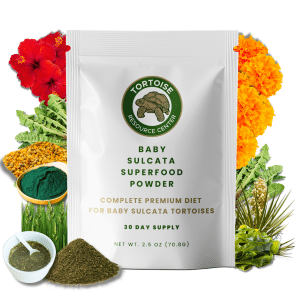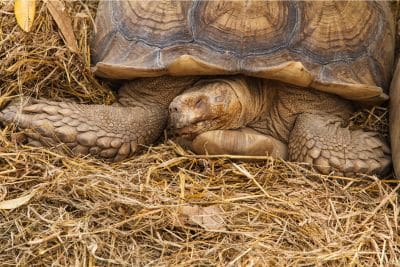To properly care for a tortoise, you must provide a habitat and care regimen that mimics several of the environmental parameters your pet would experience in the wild.
For example, you’ll need to provide your tortoise with appropriate temperatures, a suitable humidity level, and the kind of lighting he requires to stay healthy. However, it’s also important to allow some tortoise species to hibernate each year.
This is often one of the trickiest aspects of tortoise husbandry to get right, but in this article I’ll explain everything you need to know about hibernating your tortoise the right way.
Brumation vs Hibernation
Technically speaking, “brumation” is the term used to describe winter dormancy in reptiles; the term “hibernation” should only be applied to winter dormancy in mammals.
The primary differences between hibernation and brumation relate to the level of movement and alertness exhibited by the animals.
True hibernators exhibit a drastic decline in heart rate and breathing, and they fall into a very deep sleep. Brumating reptiles, on the other hand, do not fall into a deep sleep, and they may even become active for brief periods. For example, brumating tortoises may emerge from their burrows on exceptionally warm winter days to bask.
Nevertheless, for the purposes of this article, I’ll use the term “hibernate” from this point forward, as it is a more familiar term.
Care Guidelines When Hibernating Tortoises
Hibernating your tortoise is not something to take lightly. If not carried out in the proper way and for the correct length of time, hibernation can present serious health risks for your pet.
To give your tortoise the best chance of hibernating properly and remaining healthy throughout the process, you’ll want to follow the steps outlined below. Just note that the process will differ depending on whether you maintain your tortoise indoors or outdoors.
How to Hibernate Indoor-Reared Tortoise
While it is generally easier to maintain many domestic tortoise species indoors, indoor hibernation presents several challenges.
The most significant challenge relates to temperature regulation. For starters, you’ll need to devise a way to provide your pet with temperatures between 37- and 44-degrees Fahrenheit, which is far lower than the temperature most people maintain their homes at.
Some keepers try to do so by building a portable hibernation box (called a hibernaculum), and then keeping the box in a garage or outbuilding. Others place hibernacula inside refrigerators calibrated for proper hibernation temperatures.
Regardless of where you decide to keep your pet for the duration of hibernation, you’ll want to employ the following basic process:
1. Cease feeding your tortoise.
Once you have decided when to hibernate your tortoise begins hibernating and stops being able to warm his body each day, his body will (temporarily) stop digesting food. This means any food in his digestive tract may start to decay, which can lead to serious illness. So, it is imperative that you allow your tortoise to completely empty his digestive tract before hibernating.
Stop offering your tortoise food one to two weeks before you plan to start simulating a seasonal change. It is also wise to allow your tortoise to soak in a small amount of room temperature water for several 30-minute periods during this time. This will help ensure he’s hydrated and encourage him to defecate.
2. Gradually reduce the temperature and photoperiod.
Now that your tortoise has an empty digestive tract, you can begin altering his climate. A gradual shift from “summer” conditions to “winter” conditions is generally preferred, as this mimics the way tortoises enter hibernation in the wild.
So, over the course of two to four weeks, you’ll want to slowly reduce the enclosure temperatures and the number of hours the enclosure lights are on each day. You won’t be able to get the enclosure temperatures low enough for hibernation, but the general cooling trend will help trigger your pet’s body to prepare for dormancy.
By the end of the transition period, you should be aiming to only turn the enclosure lights on for an hour or two each day.
3. Initiate hibernation.
After spending a few weeks gradually reducing the enclosure temperatures and photoperiod, you can initiate actual hibernation.
To do so, you’ll want to move your pet to the hibernacula you intend to use, which you’ll then move to a cool spot or refrigerator. For your tortoise’s comfort and security, you’ll want to half-fill the hibernaculum with substrate. Also, be sure that you install a thermometer probe in the hibernaculum box, so that you can monitor your pet without having to disturb him.
Once you’ve placed the hibernaculum in the desired location, you’ll simply want to allow your tortoise to sleep. Don’t handle or disturb him unless absolutely necessary during this time but be sure that you monitor the hibernaculum temperatures throughout the duration of hibernation.
Are You Starving Your Tortoise?
Save 10% on premium tortoise food and supplements from Tortoise Resource Center on Amazon now using code BUYNOWGET10

Sulcata Vitamin & Mineral Topper Supplement
30-Day Supply | 2 oz (56 g)
$24.99

Baby Sulcata Tortoise Superfood Powder
30-Day Supply | 2.5 oz (70.8 g) Bag
$24.99
4. Gradually restore the temperature and photoperiod to normal levels.
Once your tortoise has hibernated for the intended amount of time (more on this later), it is time to begin “waking him up.”
As when allowing your pet to enter hibernation, you want to carry out this process gradually. Start by simply returning him to his enclosure, but only provide a few hours of light and warmth for the first day or two. Over the course of a week, gradually begin providing warmer and brighter conditions.
Many keepers like to go ahead and resume a regular soaking regimen at this time. This not only helps to ensure your tortoise will be adequately hydrated, but it will also help encourage activity.
5. Resume feeding your tortoise normally.
Once the temperature levels and photoperiod are back to normal, you can begin feeding your pet again. Do not be alarmed if your pet doesn’t begin eating immediately – it occasionally takes several days for tortoises to regain their appetites.
6. Monitor your tortoise carefully over the course of the next few weeks.
If all goes well, your tortoise will resume normal activity patterns in the days and weeks following hibernation. However, it is important to monitor his health closely. If you note any signs of illness – particularly respiratory symptoms, such as wheezing, labored breathing, or nasal discharge – contact your vet at once.
How to Hibernate Your Outdoor-Reared Tortoise
Hibernating tortoises kept in outdoor enclosures is often simpler than doing so with those maintained indoors, provided that the local climate is conducive to doing so.
The process for hibernating outdoor-reared tortoises will largely mirror the process described above for indoor tortoises (including the need to provide a fasting period before cool temperatures arrive), except that the natural climate will do most of the heavy lifting for you.
The most challenging aspect of hibernating outdoor-kept tortoises is providing a suitable hibernaculum. A deep burrow will suffice as long as flooding isn’t a concern. Alternatively, you can provide a very insulated box of some type, with only a small entrance door (which you may want to close during hibernation).
But no matter which type of hibernaculum you provide, you’ll want to install a thermometer probe inside to allow you to monitor the temperatures. If the temperatures rise above the mid-40s Fahrenheit or drop below 35 degrees Fahrenheit, you’ll need to bring your tortoise indoors.
Do note that the natural winter conditions your tortoise will experience outside will often last longer than many keepers would consider ideal. The only way around this issue is to temporarily bring your pet back indoors when you want to end the hibernation period. You can then place him in a warm and bright enclosure until the outside temperatures reach acceptable levels, at which point you can return him to his outdoor enclosure.
However, this is not always possible, so keepers who maintain their pets outdoors may simply have to accept that the hibernation period will last for longer than they’d like.
How Long Do Tortoises Hibernate?
Not all tortoises hibernate, and those that do have differing hibernation periods that typically correspond with the length of the winter in the species’ home range. For example, Hermann’s tortoises (Testudo hermanni) live in areas with shorter winters than Russian tortoises (Testudo horsfieldii) do.
Accordingly, Hermann’s tortoises typically hibernate for three to four months, while Russian tortoises may hibernate for six months or longer.
Nevertheless, a six-month-long hibernation period is generally not recommended for captive individuals. These kinds of lengthy hibernation periods may not only lead to long-term health problems, but they will also prevent your tortoise from consuming as much food over the course of the year. This will increase the length of time it takes your tortoises to reach breeding size and slow down the rate at which female tortoises can produce eggs.
For example, tortoises that hibernate for only two months will essentially have 10 months during which they can feed and replenish the fat stores necessary to trigger egg production. On the other hand, tortoises who hibernate for four months only have eight months during which they can feed. Such tortoises may not be able to produce eggs every year – they may require two or three years between egg clutches.
Accordingly, most experienced keepers provide a hibernation period of between 8 and 12 weeks. However, the ideal hibernation period length will vary by species, as well as the climate of your area.
Citations
- South Carolina Aquarium – Reptile Brumation
- Arizona Exotic Animal Hospital – Hibernation Recommendations for Turtles and Tortoises
- Tortoise Trust – Refrigerator Hibernation for Tortoises & Turtles


